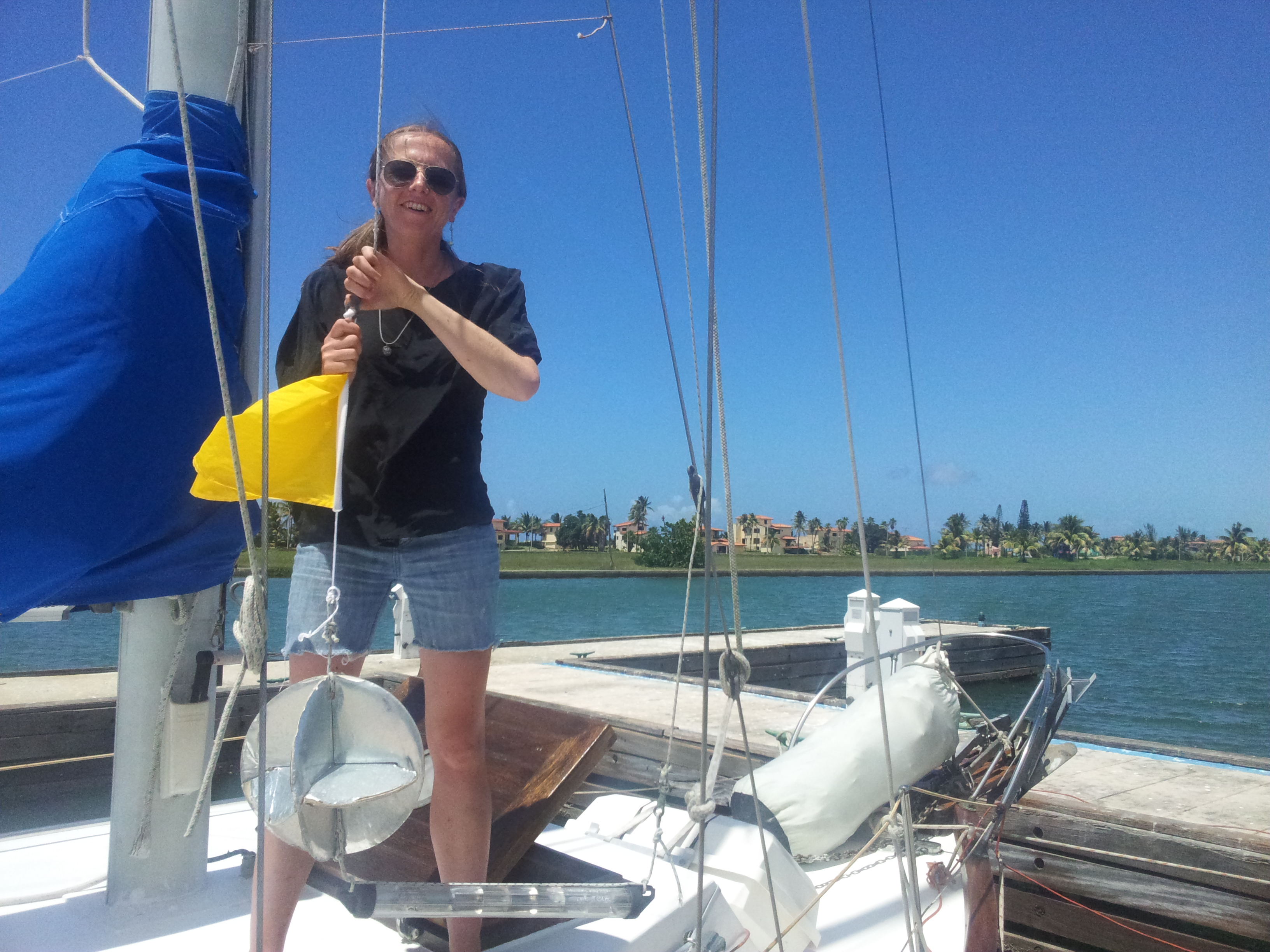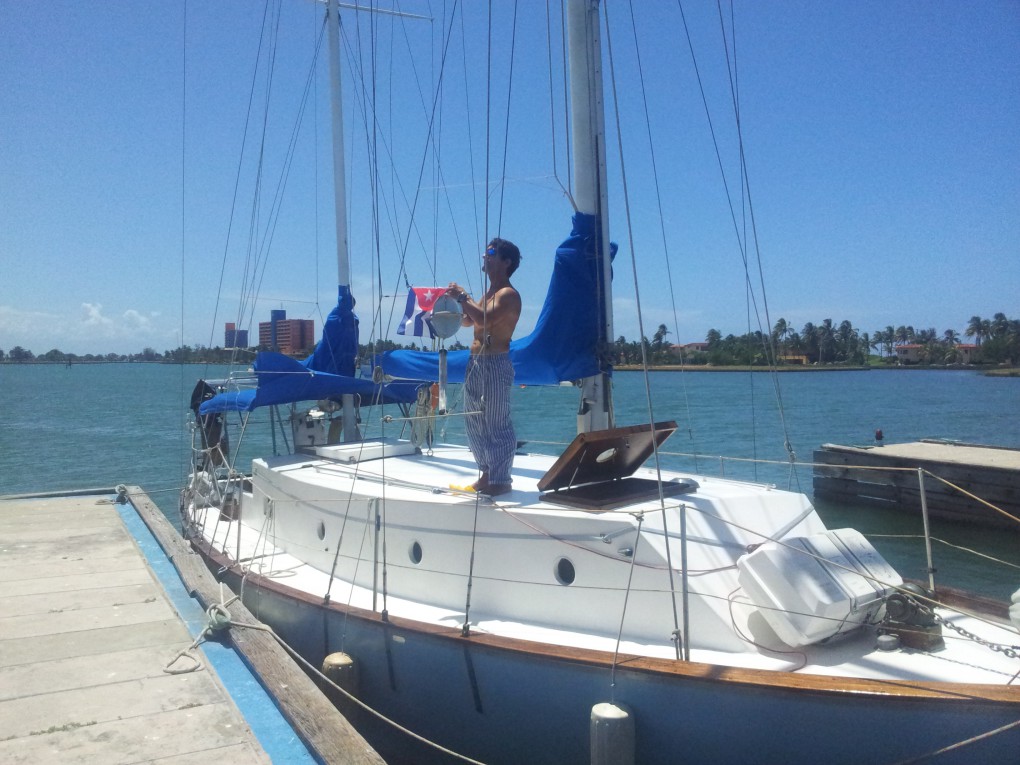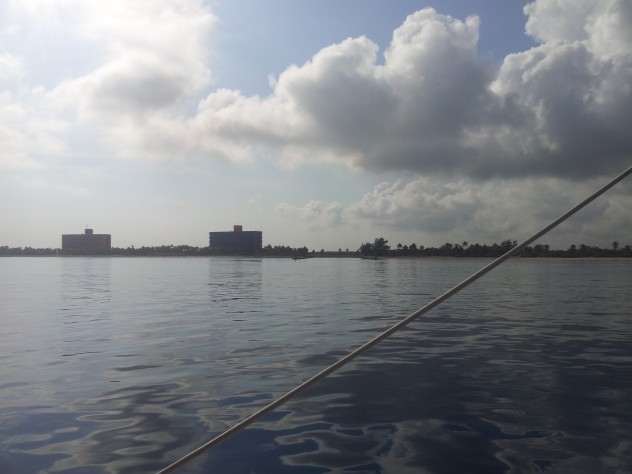Arriving in Cuba under sail from Florida
‘Landfall’ – the first sighting of land when approached from seaward. By extension, the term is sometimes used to refer to the first contact with land by any means, as by radar.
Boater’s Pocket Reference
As the afternoon wore on, and we got more and more stressed about making it in time, we reefed less and less. The last squall, we sailed under full canvas. The boat dealt with it well, and we steered into it. It was about four in the afternoon. Four hours til nightfall, and still no sign of land. There was a large shipping lane which we were in the middle of, but thankfully it was empty of ships, and indeed we wished we could come across a fishing boat, to tell us we were coming to land at last.
Passage Making – The Labours of a Gimballed Galley Stove
‘Gimbal’ (also gimbals) noun. a contrivance for keeping an instrument such as a compass or chronometer horizontal in a moving vessel or aircraft…ORIGIN C16: var. of early gimmel… gemel ‘twin hinge’…
Oxford English Dictionary
Finally, as Dorry was resting in the saloon, I reckoned I had caught sight of something. I had assumed Cuba was quite mountainous, and had been getting increasingly de-moralised. We were close, it seemed, and now, coming west, were hoping to catch Gulf Stream counter-currents, going the other way. In the distance, through the haze, I finally saw what looked like a while post. I thought it was perhaps a marker, but it soon became clear it was a lighthouse, and the chart said it was Cayo Piedras, at the entrance to Bahia Cardenas! We had made it! But the lighthouse also said we had a long way to go to the west. The engine was already running, but I pushed the throttle forward a bit more, willing us to get there, longing for my bed in the bright sunshine.
‘Why do we do these things?’ I wondered, and as I write this, I know why: because we always forget the worst bits and remember the best. And the best bits are worth it, it seems.
As we clawed our way along the coast westwards, landforms slowly became clear. At this point, twelve miles from Cuba or so, was my big moment as skipper. We had read instructions in the pilot guide about how to make contact, but everything about Cuba seemed shrouded in mystery. ‘It’s very old-fashioned’ was the general impression, and I knew that the Coastguard, Harbourmaster, and Port Authorities would expect to treat me like a sea-captain, but in Spanish.
It had been a long time since I had used the few words of Spanish I have which get me through basic sign-language conversations, and, fatigued, queasy, and stressed, I had to gather myself for a role I had never before played. I thought of Joseph Conrad and Scott of the Antarctic as I took the microphone of the VHF radio, tuned to Channel 16 and said, ‘Marina Darsena, Marina Darsena, Marina Darsena, this is the british yacht Sandpiper’, into the mouthpiece.
There was silence, apart from our engine throbbing away, hot and bothered under the floor . One of us had a sudden though, and hurriedly took the flag-set out. We needed the Quarantine Flag. The plain yellow flag for the alphabetical letter ‘Q’, has for centuries been used to represent a boat which is still its own oceanic nation state, which remains isolated and requests official ‘clearance to enter’ a country. We still flew the Stars and Stripes of the American courtesy flag from our ‘yard arm’.
The second channel – Cuban Port Authorities working channel – was Channel 72, so I tuned the radio to that. I knew that ‘Yate’ was the word in Spanish, and wanted to emphasise that we were not american. Given the almost superstitious way with which Cuba is viewed by american sailors, I more than half-expected a gunboat, and certainly a boarding at sea. I had chosen my words carefully.
The radio honked with voices over the noise of the engine. I strained to hear, pressed ‘Transmit’ again, and repeated my hail.
‘Now listen to me very carefully.’ A clear voice finally came out of the radio in English. What are your vessel details? How many aboard, length, beam, type of vessel were questions I expected. Not all the questions were clear, but I tried to guess what they were, and give the right answers. I still had no idea if Cuba would ‘accept’ us, that we might somehow not be legitimate.
‘What are your intentions’ came the question. ‘Peaceful?’, I wondered… Then I knew I needed to describe where we wanted to come in. ‘We intend to enter Marina Darsena’.
‘Which way do you intend?’ confused me, as there is a way in for mast-less boats from the Bay of Cardenas. But we needed to come in through the Sea-inlet. I was very nervous of this, the ‘Pasa Malo’ or ‘Bad Pass’, as we had read of its hazards. But the Coastguard understood immediately. As he asked me about my arrival time, I saw, horrified, a huge bank of dark grey storm clouds looming out of the east. We had an hour and a half before dusk to make this tricky entrance into an embargoed country, in another language, after thirty-six hours on the go, in the middle of a lightening storm. And what a storm it was. Our jubilation at seeing the cuban coast appear was completely swamped by our complete consternation as to how to get in. As we neared the entrance, we saw what must have been local boats scuttling into harbour, presumably to escape the looming storm. As I now know, they were coming out to look for us and possibly help to guide us in. If our customs people went off-duty at 8pm, how would we sign-in?
I decided, as the first storm hit, that we would have to go out again, so we turned around and motored full-speed north, trying to escape the vicious bolts of lightning which were raining down on our destination. We have known many boats hit by lightening. It is a life-changing event, and will disable you for years, whilst you gather resources to refit your boat. We had just escaped the boatyard. I knew we had only half an hour to get back in, and another storm appeared immediately behind the first. But we had no choice. Heaving-to all night in the Straits of Florida in that relatively busy shipping area was possible, but we were so tired I felt as if we could loose everything at the drop of the hat. We had gone all-out for Cuba so far, so I turned the boat around, and in we went. At least we had seen the red and green markers of the entrance.
As we got close, I radioed the port again. ‘Hurry up, as the customs will go off duty soon.’ was the reply. But we were, quite frankly, terrified of going in too fast. Afterall, the entrance was called the ‘Paso Malo’. All I knew was that we mustn’t go there in a north wind, which I had studiously avoided, but as we steamed in as fast as we could, not really knowing how far the dock was after the entrance, I was flumoxed by the lack of hazards. ‘What’s the catch?’, I was thinking, as we turned carefully up the channel, and saw the dock, half a mile up, clear, and easy to negotiate.
Looking ‘down the barrel’ of El Paso Malo from the bow of Maggie M on our second crossing to Cuba.
‘Even if we have to anchor in the inlet, it will be safer than out here’, we had decided, and we had our anchor and chain loose and ready to shoot. I had been under the impression that there were miles of inland canal to negotiate inside the inlet, but as we rounded the corner of the jetties, with their hazardous rock outcrops, and Dorry calling to be careful not to cut the corner of the turn because of submerged rocks, the marina pontoons were clear in front of us, up a clearly-buoyed channel, and as we approached, we could see the numerous officials waiting on the dock for our arrival.
There had been nothing particularly difficult about ‘El Paso Malo’, except our tardiness, and as we glided up to the dockside, and ropes were seized by expert nautical hands, I was relieved, if still apprehensive, to have arrived. I went to step off the boat, and as I did so, I was signalled back-on. Then the procedures started.
Clearing-in Procedures
I have been around enough to know that procedures are a necessary evil, but it was still fascinating to see how the sequence of clearances was followed to the letter in Cuba. There are no concessions made for pleasure boats in Cuba, which may be why there is a myth of beuaucracy in the USA. If you are clearing a boat in, then you are the Master of the Vessel, and responsible for all ‘souls’ on-board, its cargo, and its safety. Having learned about the sea from british maritime adventure books, I quickly recognised it as part of the vocabulary of the sea. Perhaps for americans it feels like an assault on their freedom, and for us british like reassuring conformity. Either way, being treated the same way as a merchant sea captain brought home both my sense of responsibility and also a comfortable sense of immense pride; I had completed my first international commission!
The lines were still being tied when the first officials came aboard, as I had asked to ‘spring’ the boat – to tie-on mooring warps to stop the bow of the boat from riding into the pontoon, and to allow it to rise and fall with the tide. First the Doctor came aboard, politely taking his shoes off. Joel spoke good english, and by the end of the visit we were clapping eachother on the shoulder and arranging future social meetings once we had rested and cleaned the boat. He checked our health with a simple series of questions related to personal backgrounds as well as recent exposure to disease. A cursory look at both of us showed him that we weren’t jaundiced or diseased, and I think it helped that we wee a couple, and that our boat was clearly an organised home. Immigration, accompanied by Guarda Frontera came aboard next. It was fun to see the Guard, Kalashnikov under his arm, courteously taking off his boots , and stepping aboard deferentially, with holes in his socks! We went through our boat documents – registration and passports – with them. Sweat always pours off these officials as they struggle in the their immaculate uniform in the intense head, and handkerchiefs are abundant. Our customs lady was meticulously glamorous, with unfeasible false nails, and a veryflattering uniform. I think Fidel Castro had deployed an amazing design department for his official uniforms. Don’t get me started about how cool the motorcycle police look in their outfits!
They were wonderfully friendly, and Ismaeli, the dockmaster, entertained us with friendly jokes in english, which made the whole experience fascinating and fun, even though we were beat. Our final visitor was the handsome young military-looking guy who had waited at the dock since the beginning.. My head was reeling with fatigue, and I wondered if this was the nightmare moment I had been encouraged to expect. It had all gone too smoothly to believe so far. He seemed the most senior person, and was quite serious.. He was the Harbour Master, representing the Port Authority for this area of Cuba. But he checked the boat efficiently, looked in a few cupboards, asked us about guns on board, and safety items, and gave a broad smile very soon.
He was the last to leave the boat, with a promise of a morning visit from the last Immigration Official. The vet would come and check food and stores for cheeses, yoghurts, eggs and such. We had heard nonsense about not being able to buy food in Cuba, and hoped she wouldn’t take it all away or imprison us. All she would ask about when she did come was spices. She didn’t ask – and we didn’t tell her – about anything else. As the Port Captain disappeared we wondered if we should – or indeed could – go over and see our friend Vito whose boat was almost next door, but we decided we just needed to sleep so we collapsed into bed, exhausted but elated. Cuba.

Dorry douses the ‘Q’ flag next morning, once finally cleared by ‘Ministerio de la Veterinario y Agricultura’. Note gangster Al Capone’s house in the background.

Me, ‘bending’ the Cuban courtesy flag to the ‘Yard Arm’ (Starboard Sreader)
